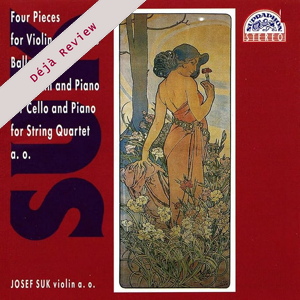
Déjà Review: this review was first published in January 2003 and the recording is still available.
Josef Suk (1874-1935)
Chamber Works Volume 3
Josef Suk (violin), Marek Jerie (cello)
Josef Hála, Jan Panenka, Ivan Klansky (piano)
Suk Quartet
Members of the Czech Philharmonic Orchestra and Suk Chamber Orchestra
rec. 1966-1992, Domovina Studio & Dvorak Hall of the Rudolfinum, Prague, Czechia
Supraphon 111533-2111 [63]
Josef Suk was the son-in-law of Dvořák and grandfather of the violinist Josef Suk, who stands at the head of about twenty musicians involved in this varied collection recorded over 25 years. Composer Suk was a fine violinist himself and occupied the second violin chair of the famed Czech Quartet for an amazing four decades (while the other personnel changed around him). This volume covers virtually his whole creative life from the 1891 Ballad for Violin and Piano in D minor, with which he introduced himself to his new teacher Dvořák in 1891, to the final work on the CD, the Sousedska for a bizarre combination of five violins, double bass and percussion, literally his last work for he died on 29 May 1935 shortly after he had played third violin at its first performance.
The music is all extremely enjoyable, highlights include the second (Appassionato) of the Four Pieces for Violin and Piano with their quirky, syncopated rhythms and the incomparable and justifiably famed duo of Suk and Panenka at their finest. This is a major work in the Suk output, a highly expressive outpouring of searing melody and kaleidoscopic moods dating from 1900 which makes compulsive listening right to the quintessentially Czech Burleska finale. The works for cello make a charming contrast with the pairing of a brooding Ballad (very Dvořák influenced) with a playful Serenade (1898). The whimsical 1917 Bagatelle, charmingly entitled ‘With Nosegay in Hand’, was probably a musical greeting written for the composer’s 15 year-old son and two of his friends, while the beautiful Barcarolle and Ballad were parts of discarded string quartets from his early student years. The 1902 Elegy, with its shades of Richard Strauss’s Ariadne auf Naxos inclusion of harp and harmonium, commemorates the anniversary of the death of the poet and dramatist Julius Zeyer, and the orchestration alone tells you a lot about its lushness, the title about its depth of feeling and mood. If the Sousedska was his last work, Suk died a happy man (if rather prematurely at 61) and described it as ‘the model case of a piece which poses absolutely no demands on either the composer or players’. It is indeed a joyfully sunny piece of music and full of fun.
The performances leave absolutely nothing to be desired. Suk’s playing is the epitome of refined style, virtuosic genius and genuine musicianship, and he inspires his colleagues to equally great heights (he appears on ten of the fourteen tracks). This is one of the most enjoyable discs I have heard for a long while.
Christopher Fifield
Help us financially by purchasing from


Contents
Melody for Two Violins
Minuet for Violin and Piano
Ballad for Violin and Piano in D minor
Four Pieces for Violin and Piano Op.17
Ballad for Cello and Piano in D minor Op.3 No.1
Serenade for Cello and Piano in A Op.3 No.2
Bagatelle for Flute, Violin and Piano ‘With Nosegay in Hand’
Barcarolle (Andante from String Quartet in D minor)
Ballad for String Quartet
Elegy for Violin, Cello, String Quartet, Harmonium and Harp Op.23
Sousedska for 5 violins, Double Bass, Cymbals, Triangle, Side and Bass Drums

















